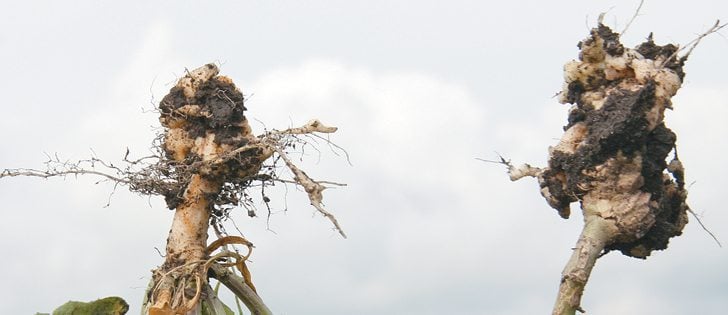Boron or lime applications, bait crops, seed treatments and crop rotations don’t stop disease
EDMONTON — Scientists, agronomists and farmers have learned a lot about what does and doesn’t work in controlling clubroot in the six years since the canola disease was found in Alberta.
The hardy microscopic spores hitch a ride in soil on machinery, wind, water and seed, and can last up to 20 years, said Clint Jurke with the Canola Council of Canada.
The disease moves easily with the soil and farmers are great at moving soil throughout their fields, Jurke told the International Clubroot Workshop held recently in Edmonton.
Read Also

Farm groups ask feds for export sales reporting
The Agricultural Producers Association of Saskatchewan and SaskCrops asks the federal government to create an Export Sales Reporting program.
“Farming activities are the major culprit to spread disease around.”
However, he said there is plenty of opportunity for the construction and oil and gas industries to also move the pathogen around.
Jurke doesn’t think the agriculture industry has done a good job of identifying the disease early when it’s introduced into a field.
Clubroot is usually spotted when someone sees big galls on plants or patches of dead canola in fields.
“That is not a good situation. That disease has probably been in the field for a number of years and produced billions of spores.”
Researchers have worked to find solutions to fight the disease, including clubroot resistant canola varieties and fungicides.
Data suggests fungicides are somewhat effective but don’t eradicate the disease. Treatments kill pathogen on the seed, but there is not enough chemical to prevent infection.
“It’s not a cost effective way of controlling the pathogen in the field,” he said.
Some studies also show boron will reduce clubroot infection, but the concentration required is phytotoxic to canola plants.
Researchers originally thought adding lime to the soil would stop infections because they believed clubroot wouldn’t survive in soil with high pH. There is evidence that this will reduce incidence of the disease but it doesn’t stop the infection.
“It’s not the most cost effective process,” Jurke said.
The idea of bait crops was tossed around as a way to control the disease. The theory was that clubroot spores would concentrate on the bait crop, which would be destroyed, and the real crop could then be planted. That has had little benefit, he said.
Jurke said tillage is one of the biggest ways to spread the disease.
“The more often you’re in the field or pull iron through soil, the more potential to be spreading disease around.”
As well, crop rotation doesn’t eliminate clubroot from an already infested field if the infection is being carried through the soil by equipment and susceptible weeds aren’t controlled.
However, Jurke said crop rotation does work when used in conjunction with resistant varieties. It won’t work if farmers continue to use susceptible varieties, he added.
Jurke said he has heard stories of farmers planting resistant varieties on heavily infested soils and harvesting yields of 55 bushels per acre.
“It is not something that is bullet proof. It’s one of those tools that could break if you use clubroot resistant varieties in tight rotation.”
Eight varieties of canola are registered with resistance to clubroot with two different sources of resistance. Jurke recommended alternating between the two sources.
Seeding dates also have affect clubroot infection. Seeding early gives canola a better chance of developing and helps reduce infection.
Sanitizing equipment is one of the best weapons for controlling the disease, but it requires a significant time commitment. If farmers can’t clean their equipment, they should seed the fields in a strategic order from least infected to most infected.
Early identification of the disease can help contain it, especially if clubroot is only in a small area within the field.
Reduced tillage will also reduce the disease’s spread.
Studies have shown that the disease is found 90 percent of the time at field entrances, with less infestation farther into the field. Seeding the entrance to grass or changing the approach into the field may reduce the spread, he said.
Controlling weeds such as stinkweed and shepherd’s purse, which are hosts for the disease, also help control the disease.















